Pros and Cons of Meishan Pigs – Characteristics and Complete Guide
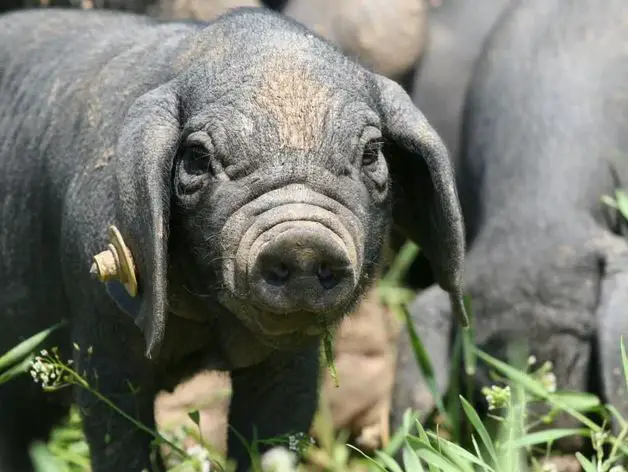
Not only is the Meishan have a unique appearance, but it’s an unusual breed of pig as well. The Meishan is a miniature pig which is named after a province in China.
History
The Meishan pig came from China and is usually found only in China. The breed is now considered critically endangered. Part of the problem is that this breed of pig grows slowly compared to other pigs and has lots of fat.
The Meishan pig is one of the oldest heritage breeds of domesticated pigs in the world. Some of the more popular or similar breeds are preferred to being raised by farmers for livestock, like the Berkshire pigs.
These pigs are from a subgroup of pigs called Taihu pigs and come from Lower Changjiang River Basin from the Taihu valley. They are small to medium in size.
In the 1980s, three labs in the United States imported Meishan pigs. Two of the labs bred them because of the early sexual maturity and size of the litters. But because of the abundance of fat and slower growth rate, the breeding programs were shut down. This meant that the Meishan pig breed could go extinct in the United States.
But some zoos and farmers wanted the chance to raise them to keep the genetics available. Plus, for public viewing in zoos and pig farms. So all of the Meishan pigs in the United States come from these pigs used for research.
What Do Meishan Pigs Look Like?
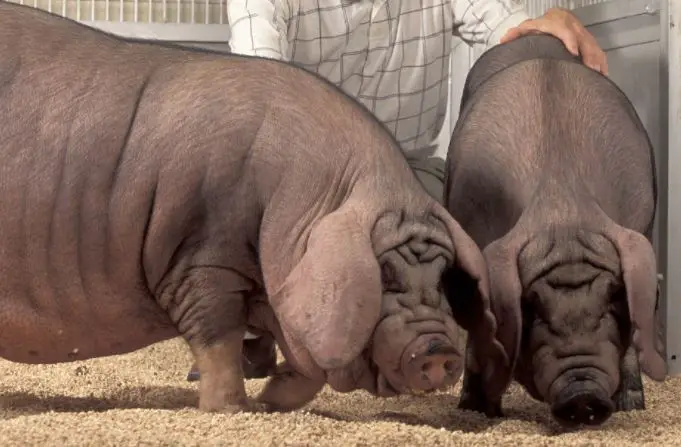
These pigs have large wide foreheads that are thick with heavily wrinkled skin. The big floppy ears sometimes cover the eyes and overlap the corner of the mouth. In fact, the ears can remind you of a geisha hand fan.
A Miesha has a short to a medium nose that’s turned slightly up. It’s usually black and pink or solid black. The nose can have spots of light color like pink or peach sometimes.
The neck is short to medium, even with the body but fat and heavily wrinkled. The faces are large and look bigger than they are because of all the wrinkles.
The body is medium in size and also heavily wrinkled with thick skin. The pig has a black coat covered with sparse hair. The skin underneath the stomach is purple-red. The Miesha has a strong back that is level to a slight sway. The tail is medium hairy, long, black, and when at rest, it lies straight. Sometimes the tip of the tail can be white.
The legs can vary with some short, some long, and are black with white stockings. The legs can support the size of the pig because they’re strong. The Miesha has heavily wrinkled, thick black skin, and the hair can be sparse or heavy depending on the climate where it’s living.
There are only two colors of a pure Miesha, which are pure black and dark brown. However, mixed or crossbred Meishan pigs can be of different colors.
Characteristics

Size:
The average size of an adult Meishan pig can be about 28-32 inches tall for the males with a chest about 39 inches around. The average weight runs around 134 pounds. The females are about 25-30 inches tall. Therefore, they are considered on the small to medium side.
Personality:
Although these pigs can give a depressed appearance with their dark color, heads down, and their ears sometimes covering their eyes, but they have an easy-going personality. This is a silent breed of pig that doesn’t make much noise.
They are incredibly docile when compared to other pig breeds. Nevertheless, these are a wonderful pigs for people who are afraid of pigs because they are gentle and peaceful.
These pigs would instead take a nap than spend time with other pigs and are considered sleepyheads. This breed doesn’t fight or attack other pigs, animals, or people unless they are still a piglet. Piglets will make noise or play fight since they are still little.
Plus, as long as the pigs feel safe and sound, they will stay where they are and not try to escape their enclosures like other pigs.
Tendency to Bite:
Miesha pigs have non-sharp teeth and regular teeth but can still bite food really hard. The needle-shaped teeth are clipped soon after a pig is born, and the sharp teeth grow in as normal teeth.
All pigs have tusks, and that includes the Miesha. Male and females both grow tusks, with the females having smaller or shorter tusks. On the females, the tusks barely grow long enough to protrude from their mouths. This was one way to identify if a pig in the wild was either a sow or boar.
The tusk could be removed on a domestic pig since it doesn’t serve any purpose in captivity. However, since the tusk is part of the jawbone, it won’t grow back if it’s removed.
Nails and hooves:
Pigs also have nails, hooves, and declaws that will all need to be trimmed once a year. If your pig is an indoor pig, then trimming will need to be done more than once a year.
Intelligence:
The Miesha pig is not only peaceful but intelligent too. They learn quickly and remember things. A big brain and loving personality are in that small to medium body and cute wrinkly face. These pigs aren’t competitive at all and would instead let the other animal win.
Plus, Meishan pigs can be housetrained if you want to keep one as a pet. The pigs can learn how to use a litter box and do tricks, such as play fetch. Treat rewarding works well with these pigs when used as a training method.
Exercise Needs:
The Miesha pig adapts readily to being raised in a pasture. If the pasture is nutritious, the adult Miesha can thrive on it.
Habitat:
These pigs are usually found in a milder climate area. They aren’t hard to maintain and can thrive just about anywhere as long as the weather isn’t an issue. However, the Miesha pig does function better with cool or mild temperatures.
But they can still have a sensitivity to extreme heat or cold. So they also need to be sheltered from storms and any kind of storms.
Life Expectancy:
The life expectancy for Miesha pigs are 15 to 20 years.
Price:
The average cost for a Miesha pig, if you can locate a breeder, is about $500 for a male and $900 for a female. Buying one may be difficult because they are a rare breed. You need to be extremely careful when purchasing a Miesha pig because you could buy a mixed breed. Always choose a reputable breeder in your area.
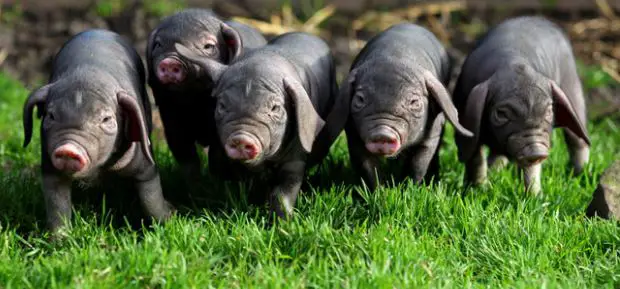
Pros
Maintenance:
Because this breed isn’t picky eaters, they don’t need large spaces like other pigs. Plus, they have natural foraging skills, which let them find food outdoors. But you still need to feed them a good brand of pig feed to keep them healthy.
These pigs genuinely do have a cast-iron stomach and can consume roughage. Roughage is fiber or bulk and is an indigestible compound that a human can’t even absorb. Roughage is found in vegetables, grains, legumes, and many fruits.
The Miesha pig is also immune to certain diseases that other pigs aren’t. Plus, as long as they have a stable shelter, water, food, and protection from predators, they can thrive being on their own. Breaking free and running away isn’t in their nature, so expenses when putting up fences can be cut. Electric fences are rarely used with these pigs since they are not a rooting breed.
Good mothers:
The females can give birth to up to 22 piglets at one time. Piglets’ faces resemble a pug which makes them sort of cute. Sow Meishan pigs are excellent mothers and can raise and care for their young without accidents.
Accidents that happen as a mother sitting on her babies or accidentally choking rarely occur with this breed. Plus, the females can efficiently feed their babies without help.
Environmentally friendly:
A Meishan has the most negligible negative impact on the environment than any other pig breed. They don’t attack or bother other animals; the adults don’t shriek or yell unless it’s breeding season.
This breed is a grazer, and you have to wake them up to feed them. However, when they receive proper nutrition, the Meishan has the lowest impact on woods and pastures.
Because of the high breeding rate productively, farmers can keep small breeding herds while producing the same number of piglets to sell or use.
Gentle nature:
These are gentle, peaceful animals that would instead run away and hide than fight. The Meishan pig can feel compassion and sense grief both from other animals and their owners. However, they can become bored if isolated or become uneasy if they aren’t comfortable.
Cons
Slow growth:
If you’re looking to raise pigs for income, the Meishan pig may not be your best choice. The slow growth of these pigs is why they may not be the most favorable choice.
But the Meishan pig can reproduce at 2 to 3 months of age which may make up for the lack of rapid growth. Despite being able to reproduce sooner, these pigs still have a high rate of success with births with a number of piglets.
A lot of fat:
These pigs have abundant fat, which some farmers find unfavorable. The breed develops fat even though they can be fed appropriately and aren’t picky eaters.
Inactive:
This is not a lively and active pig. If, as an owner, you’re looking for that type of pig, then the Meishan pig isn’t for you. These pigs are quiet, docile, and peaceful and can be found to be boring. But this really isn’t too much of a con if you prefer a docile pig.
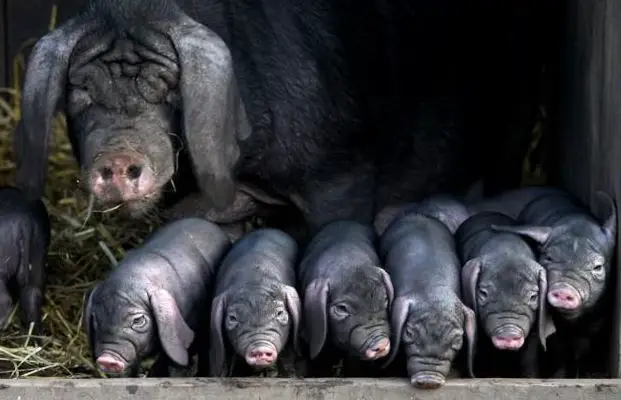
Other Information
Q: Is it illegal to raise Meishan pigs since they are endangered?
The condition of an endangered species population can significantly affect whether you can own them legally or not. But owning any kind of pig, you will often have to obtain a license. That means having the ownership registered and legalized.
Most parts of the United States and parts of the UK require licensing and registration of pigs. This is regardless of whether they are being kept as pets or being raised as livestock. Unique breeds, rare breeds, or endangered breeds could require a special license or additional requirements.
Q: Taihu pigs and Meishan pigs, how similar are the breeds?
The Meishan pig is part of the breed of Taihu pig. These two breeds have few, if any, physical differences at all. However, both of these pigs are dark-colored, have wrinkled faces and bodies, and have floppy ears.
The Taihu pig was the original pig that broke off into several other branches. These branches of pigs were given different names. The names of the Taihu pigs were different according to which district in China they were raised in. These pigs developed different diet preferences because of the difference in their environments.
The different branches of the Taihu are called strains, and the list of the known Taihu strains are as follows:
- Meishan
- Fengjing
- Hanging
- Erhualian
- Jiaxing
These assorted strains are found in different areas in China. It’s why each pig breed has its own name instead of being all lumped together under the Taihu breed. This is a very common practice for many Asian countries to have different names for one item in other parts under one country.
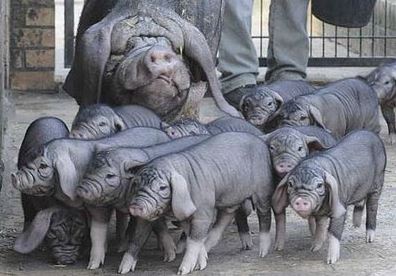
Conclusion:
If you want a smaller pig as a pet, then a Meishan is your best bet. The pig is on the smaller side, and with its easy-going personality, lack of making noise, and friendliness, it makes the perfect pet.
If you would like more information, click the link and check out the video:
https://www.youtube.com/watch?v=3J0XRpWUv9M


